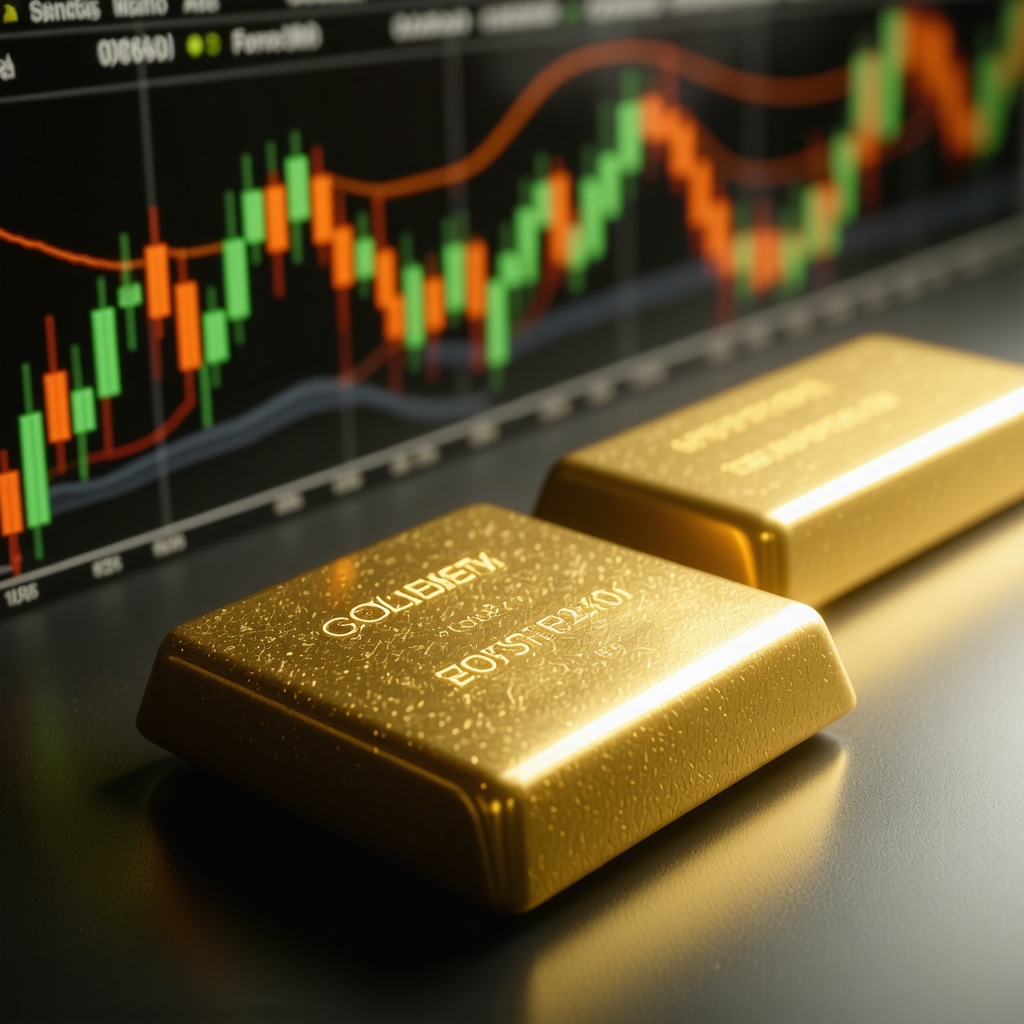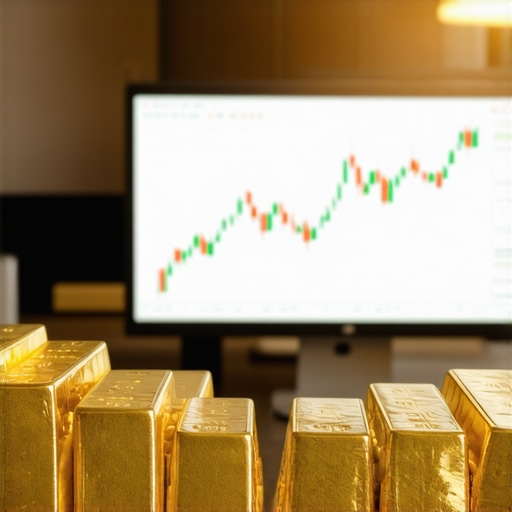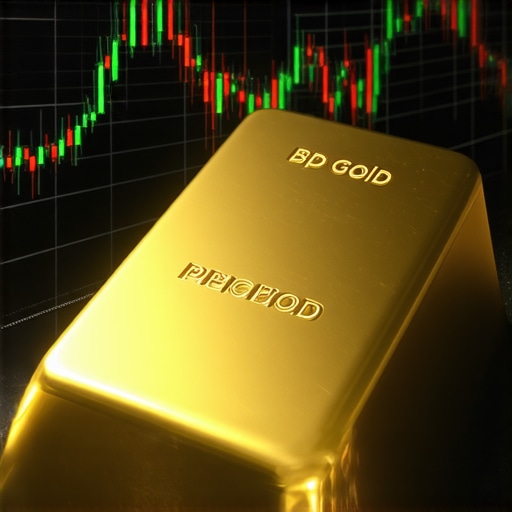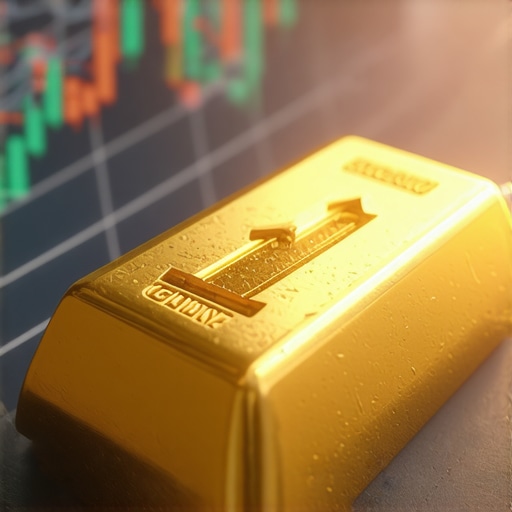Decoding the Future: Why 2026 Is a Pivotal Year for Gold Prices
As global economic tides shift unpredictably, discerning investors are turning their gaze to gold — a timeless refuge amid financial tempests. The gold price forecast for 2026 is not merely a number but a complex narrative woven from geopolitical currents, technological advancements, and evolving market dynamics. Understanding these interlaced forces offers a competitive edge in portfolio strategy, extending beyond basic price speculation.
Unveiling the Subtle Dynamics Shaping Gold’s Trajectory
Global Monetary Policies: The Puppeteers Behind Gold Valuations
Central banks around the world continue to influence gold prices profoundly through their monetary policies. The increasing trend of quantitative easing and fluctuating interest rates directly affect gold’s appeal as a hedge against inflation and currency devaluation. For instance, the Federal Reserve’s stance on interest rates will likely dictate gold’s safe-haven demand, impacting investor behavior throughout 2026.
Supply Chain Constraints and Mining Innovations: Balancing the Scales
The gold supply landscape in 2026 will be a tale of two forces: constrained mining output due to environmental regulations and geopolitical tensions, contrasted by technological advances in extraction methods. These opposing trends could tighten supply, potentially driving prices upward as demand remains robust, especially from emerging markets.
Investor Sentiment and Market Volatility: The Psychological Catalyst
Market sentiment, often swayed by economic uncertainty and geopolitical conflicts, remains a volatile driver of gold prices. As inflationary pressures persist globally, investors might increasingly view gold as a reliable store of value. This behavioral trend can amplify price swings, underscoring the importance of strategic timing in gold investments.
How Will Emerging Market Demand Influence Gold Prices in 2026?
Emerging economies, particularly in Asia, are projected to escalate their gold consumption for both cultural and investment purposes. This surge, fueled by rising disposable incomes and growing middle classes, could significantly buoy global gold demand. According to the World Gold Council, Asia’s gold demand has historically provided a resilient backbone to prices, a trend expected to intensify leading into 2026 (source: World Gold Council Gold Demand Trends 2024).
Practical Wisdom: How Should Investors Position Themselves?
Expertise in navigating gold investments in 2026 involves blending traditional holdings with diversified instruments like gold ETFs, futures, and mining stocks. Understanding nuances such as the impact of futures trading on price volatility can enhance portfolio resilience. For those seeking physical assets, authenticating gold coins and bars is paramount to safeguard value — resources like physical gold authentication guides offer indispensable insights.
Moreover, integrating gold with other asset classes, as explored in effective portfolio balance strategies, can optimize risk-adjusted returns during 2026’s uncertain markets.
Engage With Us: What Are Your Predictions for Gold in 2026?
We invite you to share your insights or questions about the gold price forecast for 2026. Join the conversation, exchange perspectives, and stay informed to make strategic decisions in this evolving market.
Technological Disruptions and Their Ripple Effects on Gold Markets
Beyond traditional supply and demand, emerging technologies are reshaping how gold is mined, traded, and valued. Blockchain applications in gold trading are increasing transparency and reducing fraud, while AI-driven analytics enable sophisticated market predictions. These innovations can potentially reduce transaction costs and improve liquidity, thus impacting gold price behavior in nuanced ways. Investors should consider how these technological shifts might alter historical price patterns and market access.
Geopolitical Tensions: Fueling or Dampening Gold’s Safe-Haven Status?
Geopolitical risks remain a perennial catalyst for gold price surges. Conflicts in resource-rich regions or trade disputes between major economies often trigger flight-to-safety buying, pushing gold prices upward. However, evolving diplomatic resolutions and multilateral agreements can equally diminish these pressures. The delicate balance of these factors in 2026 requires investors to monitor geopolitical developments closely, as sudden escalations or de-escalations can swiftly recalibrate market sentiment.
What Are the Emerging Risks That Could Unexpectedly Shift Gold Prices in 2026?
While many factors influencing gold prices are foreseeable, certain emerging risks could introduce volatility unexpectedly. These include rapid shifts in central bank policies, unforeseen technological breakthroughs in gold extraction, or geopolitical upheavals in key consuming or producing countries. For example, a sudden tightening of global monetary policy could depress gold prices by strengthening fiat currencies, while breakthroughs in recycling technology might increase supply without new mining. Staying attuned to such developments is crucial for proactive investment strategies.
According to the World Gold Council’s Gold Market Analysis 2025, the interplay of these multifaceted factors underscores the complexity of forecasting gold prices and highlights the necessity of a multi-dimensional approach to investing.
Integrating Gold Into Sophisticated Portfolio Models
For professional investors, gold’s role transcends a mere inflation hedge; it becomes a strategic tool within diversified portfolios. Incorporating gold assets through ETFs, futures, and mining equities requires an understanding of correlations with other asset classes, volatility profiles, and liquidity considerations. Advanced portfolio optimization techniques can help balance exposure to gold against equities and bonds, improving risk-adjusted returns especially during periods of economic stress. Resources like our effective portfolio balance strategies provide actionable insights for such integration.
Furthermore, for investors leaning towards physical holdings, mastering authentication and storage is essential to preserve value, as detailed in physical gold investment guides. Combining these approaches can yield a robust defense against market volatility.
Join the Discussion: How Are You Preparing Your Gold Investments for 2026?
We encourage readers to comment below with their strategies, questions, or perspectives on navigating gold markets in 2026. Sharing experiences enriches collective knowledge and equips our community to adapt to the evolving financial landscape. For further reading on market trends and investment techniques, explore our comprehensive articles on analyzing gold demand trends and gold futures trading techniques.
Technological Innovations: Transforming Gold Valuation and Market Accessibility
The integration of cutting-edge technologies into gold mining and trading is reshaping the traditional paradigms that have governed gold markets for centuries. Notably, blockchain technology is revolutionizing transparency and traceability in gold supply chains, mitigating risks of fraud and counterfeit products. By providing immutable records of provenance, blockchain enables investors to verify the authenticity and ethical sourcing of gold assets, a factor increasingly demanded by conscientious consumers and institutional buyers alike.
Artificial intelligence (AI) and machine learning algorithms are also becoming indispensable tools for market participants. These technologies analyze vast datasets encompassing macroeconomic indicators, geopolitical developments, and historical price patterns to generate predictive models with enhanced accuracy. Such analytical sophistication allows traders and portfolio managers to anticipate price fluctuations and optimize entry and exit points, thereby enhancing returns and managing risk more effectively.
Geopolitical Flux: The Unpredictable Driver of Gold’s Safe-Haven Appeal
Gold’s role as a safe haven asset is intricately tied to geopolitical stability or the lack thereof. In 2026, the geopolitical landscape is expected to be characterized by both persistent tensions and potential breakthroughs. For example, resource conflicts in mineral-rich regions or escalating trade frictions between major economies could precipitate sharp increases in gold demand, as investors seek refuge from market uncertainty.
Conversely, diplomatic advancements and multilateral agreements may temporarily ease geopolitical risks, leading to subdued gold price volatility. This duality underscores the necessity for investors to maintain vigilant monitoring of geopolitical developments, employing scenario analysis and hedging strategies to navigate the resultant market swings.
How Can Investors Effectively Hedge Against Geopolitical Risks Impacting Gold Prices in 2026?
Addressing geopolitical risks requires a multifaceted approach. Investors may consider diversifying gold exposures across physical holdings, ETFs, and derivatives to leverage their distinct liquidity and risk profiles. Moreover, incorporating geopolitical risk indicators into portfolio risk management frameworks enhances proactive positioning. Advanced tools, such as geopolitical risk indices and event-driven trading algorithms, can facilitate timely adjustments to portfolio allocations, mitigating downside risks while capitalizing on safe-haven rallies.
According to the World Gold Council’s Gold Market Analysis 2025, understanding the interplay between geopolitical volatility and gold price dynamics is critical for optimizing investment strategies in uncertain times.
Environmental and Regulatory Pressures: The Emerging Constraints on Gold Supply
Environmental sustainability is becoming an increasingly pivotal factor affecting gold mining operations worldwide. Stringent environmental regulations, aimed at reducing ecological footprints and safeguarding biodiversity, are imposing operational constraints on mining companies. These regulations often lead to increased costs and delays in project approvals, thereby tightening gold supply.
Simultaneously, social license to operate and community engagement are gaining prominence, with mining firms needing to demonstrate responsible practices to maintain stakeholder support. Failure to comply can result in production stoppages or reputational damage, further impacting supply.
On the technological front, innovations such as bioleaching and automated extraction methods are being explored to enhance efficiency and reduce environmental impact. However, the adoption curve for these technologies remains gradual, implying that supply-side constraints may persist into 2026.
Strategic Portfolio Integration: Leveraging Gold’s Multifaceted Roles
For sophisticated investors, gold is not merely a commodity but a complex instrument within strategic portfolio construction. Incorporating gold requires balancing its unique attributes—low correlation with equities, inflation hedging capabilities, and safe-haven properties—against liquidity needs and cost considerations.
Advanced portfolio models employ mean-variance optimization and stress-testing scenarios to calibrate gold allocations dynamically. This approach ensures that gold contributes optimally to portfolio resilience under varying economic conditions. Additionally, investors increasingly explore thematic investments in gold mining equities focusing on ESG (Environmental, Social, Governance) criteria, aligning financial returns with sustainability objectives.
Understanding the nuances of gold derivatives markets, including futures and options, further enhances the ability to implement tactical positions and hedge exposures effectively. Engaging with expert resources and continuous market analysis is indispensable for maintaining an adaptive investment stance.
Join Our Expert Community: Share Your Strategies and Insights on Gold Investments for 2026
We encourage you to contribute your perspectives and questions regarding gold price dynamics and investment approaches for 2026. Engaging in this discourse fosters a deeper collective understanding and equips investors to navigate the complexities of evolving markets. Explore our detailed analyses and advanced trading techniques in the linked resources to refine your strategies and stay ahead in this dynamic landscape.
Decoding the Influence of Macroeconomic Indicators on Gold’s 2026 Outlook
Beyond the immediate effects of monetary policies, a sophisticated analysis of macroeconomic indicators such as global GDP growth projections, inflation expectations, and real interest rates reveals nuanced implications for gold pricing. For example, a deceleration in global economic growth paired with persistent inflationary pressures can amplify gold’s appeal as a non-yielding asset that preserves purchasing power. Investors who integrate these macroeconomic signals into their forecasting models can better anticipate gold’s price inflection points in 2026.
Decentralized Finance and Blockchain: Revolutionizing Gold Ownership and Liquidity
The advent of decentralized finance (DeFi) platforms is redefining how gold assets are tokenized, traded, and held. Tokenized gold, underpinned by blockchain, offers fractional ownership, instant settlement, and increased liquidity, enabling a broader investor base to access gold markets with unprecedented ease. This democratization of gold investment, while enhancing market participation, also introduces new regulatory and custodial considerations that sophisticated investors must navigate.
What Are the Regulatory Challenges Facing Gold Tokenization in 2026?
As regulatory frameworks evolve to accommodate digital assets, gold tokenization faces challenges related to investor protection, anti-money laundering (AML), and securities law compliance. Jurisdictions differ significantly in their approach, creating a complex compliance landscape for token issuers and investors alike. Proactive engagement with regulatory developments and adopting best practices in governance are essential for mitigating legal risks associated with these innovative gold investment vehicles.
For an authoritative perspective on these developments, consult the International Monetary Fund’s report on digital asset regulations in commodity markets, which delineates key regulatory trends and challenges.
Harnessing Predictive Analytics: AI-Driven Forecasting Models for Gold Price Movements
Cutting-edge predictive analytics utilizing machine learning techniques are enabling investors to dissect complex datasets comprising market sentiment, macroeconomic variables, and geopolitical event probabilities. These AI-driven models offer probabilistic forecasts that enhance decision-making precision, allowing for dynamic portfolio adjustments in response to anticipated price trajectories. Incorporating such analytics into investment workflows can significantly elevate the sophistication and responsiveness of gold trading strategies.
Environmental, Social, and Governance (ESG) Criteria: A New Paradigm in Gold Investment
ESG considerations are increasingly paramount in shaping investor preferences and corporate practices within the gold sector. Mining companies with robust ESG credentials tend to attract premium valuations and investor trust, which can translate into differentiated stock performance and influence overall gold market dynamics. Moreover, ESG-compliant gold products, including certified recycled gold and responsibly sourced bullion, are gaining traction among institutional and retail investors seeking alignment with sustainability goals.
Engage with Our Expert Insights: Elevate Your Gold Investment Strategy for 2026
We invite you to delve deeper into these advanced paradigms and share your experiences or inquiries. Leveraging cutting-edge analytics, understanding regulatory landscapes, and integrating ESG factors are pivotal in mastering gold investments amid evolving market complexities. Join the discourse and refine your strategic approach to capitalize on gold’s multifaceted opportunities in 2026.
Frequently Asked Questions (FAQ)
What are the main factors driving gold prices in 2026?
Gold prices in 2026 are influenced by a confluence of factors including central bank monetary policies, especially interest rate decisions; geopolitical tensions that drive safe-haven demand; supply constraints due to environmental regulations and mining challenges; technological innovations improving extraction and trading transparency; and rising demand from emerging markets, particularly in Asia.
How does geopolitical instability affect gold’s safe-haven appeal?
Geopolitical instability often triggers increased demand for gold as investors seek protection from market uncertainty. Conflicts, trade disputes, or resource tensions can lead to price surges. Conversely, diplomatic progress and multilateral agreements may ease these pressures, resulting in muted price volatility. Monitoring geopolitical developments is crucial for timely investment decisions.
What role do emerging technologies like blockchain and AI play in the gold market?
Blockchain enhances transparency and traceability in gold supply chains, reducing fraud and enabling secure ownership verification. AI and machine learning facilitate sophisticated predictive analytics by processing vast datasets, improving forecast accuracy and helping investors optimize timing and risk management in gold trading and portfolio allocation.
Can gold tokenization via decentralized finance platforms impact traditional gold investments?
Yes, tokenization democratizes gold ownership by enabling fractional investments and instant settlements, thereby increasing liquidity and accessibility. However, it introduces regulatory complexities related to investor protection and compliance. Investors should carefully assess these factors alongside traditional physical and paper gold investments.
How should investors integrate gold into their portfolios in 2026?
Investors should consider a diversified approach combining physical gold, ETFs, futures, and mining equities. Utilizing advanced portfolio optimization techniques to balance gold’s low correlation with other assets can enhance risk-adjusted returns. Attention to authentication, ESG criteria, and liquidity considerations is also essential for a robust portfolio strategy.
What emerging risks could unexpectedly affect gold prices in 2026?
Unanticipated shifts such as sudden central bank policy changes, breakthroughs in gold extraction or recycling technologies, or geopolitical upheavals in key producing or consuming nations may introduce volatility. Staying informed and employing flexible investment strategies can mitigate these risks.
How do environmental and regulatory pressures influence gold supply?
Increasing environmental regulations and community engagement requirements constrain mining operations, potentially reducing supply and driving prices upward. While technological innovations aim to improve sustainable extraction, adoption is gradual, implying continued supply-side challenges.
What are the regulatory challenges surrounding gold tokenization?
Gold tokenization faces hurdles including varying jurisdictional compliance requirements for anti-money laundering (AML), securities laws, and investor protection. Navigating this fragmented regulatory landscape requires proactive governance and adherence to evolving standards to mitigate legal risks.
How can investors hedge against geopolitical risks impacting gold prices?
Effective hedging involves diversifying gold exposure across physical assets, ETFs, and derivatives to balance liquidity and risk. Incorporating geopolitical risk indicators and event-driven trading strategies can help adjust portfolios dynamically in response to evolving tensions.
Why are ESG factors increasingly important in gold investments?
ESG considerations influence investor preferences and corporate valuations. Mining firms with strong ESG practices often command premium valuations and attract sustainable investment flows. ESG-compliant gold products also align with growing demand for responsible and ethical asset allocation.
Trusted External Sources
- World Gold Council (WGC) – Offers comprehensive research on gold demand trends, supply analysis, and market dynamics, providing authoritative data and insights essential for forecasting and strategic investment decisions.
- International Monetary Fund (IMF) – Fintech and Commodity Markets Reports – Provides detailed evaluations of regulatory frameworks and innovations like digital asset regulations impacting gold tokenization and market integrity.
- Bloomberg Intelligence – Precious Metals Research – Delivers advanced macroeconomic analyses, geopolitical risk assessments, and quantitative models that enhance understanding of gold price drivers and market forecasts.
- Harvard Business Review – Sustainable Investing Publications – Explores ESG frameworks and their implications for mining companies and commodity investments, informing ethical investment strategies.
- Society for Mining, Metallurgy & Exploration (SME) – Offers technical insights into mining innovations, environmental regulations, and extraction technologies shaping the supply side of gold markets.
Conclusion
The 2026 gold price forecast encapsulates a multifaceted interplay of monetary policies, geopolitical volatility, technological advances, and evolving market behaviors. Gold’s enduring status as a safe haven is reinforced by emerging market demand and constrained supply, even as innovative technologies and ESG imperatives reshape the landscape. Sophisticated investors harness predictive analytics, diversify holdings across physical and digital assets, and integrate geopolitical and macroeconomic intelligence to navigate these complexities effectively. By embracing these nuanced dynamics and strategic approaches, investors can optimize portfolio resilience and capitalize on gold’s unique opportunities in the coming year. Engage with our expert community by sharing your perspectives, exploring advanced analyses, and refining your gold investment strategy to stay ahead in this dynamic market environment.











The post presents a compelling analysis of how multiple forces are converging to shape gold prices in 2026, particularly the intricate balance between tightening supply due to environmental regulations and innovating mining technologies. From my experience as an investor, the unpredictable shifts in central bank policies indeed play a significant role in gold’s appeal, especially when inflationary pressures loom. What stood out to me was the discussion on emerging market demand, particularly from Asia. Having observed the increasing gold purchases in these regions, it’s clear that cultural and economic factors are creating robust demand that supports price stability even amid global volatility.
I also find the exploration of blockchain and AI’s role in enhancing transparency and forecasting quite fascinating. These technological advancements might indeed reduce some traditional uncertainties around gold investments. However, I wonder about the regulatory complexities of tokenized gold and how investors can effectively navigate them as these digital assets gain traction.
For those actively investing in gold or considering it, how are you balancing the traditional physical holdings with newer instruments like ETFs or tokenized gold? Also, what strategies have you found effective in managing portfolio risks linked to geopolitical uncertainties and policy shifts? It would be insightful to hear different approaches, especially in light of the advanced predictive tools and ESG factors discussed here.